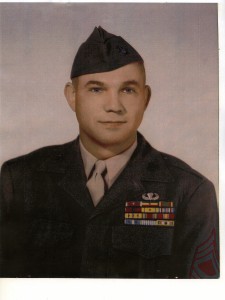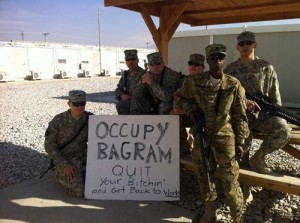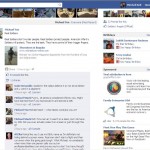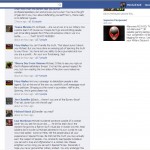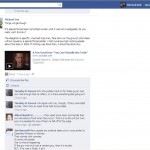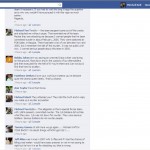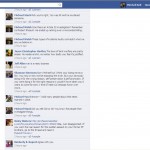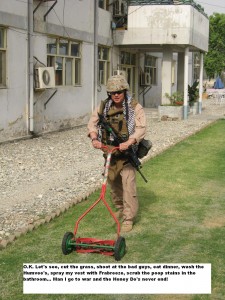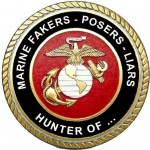November 11th, 2011 Posted in The SandGram v1.0 | 1 Comment »
This piece by Mark Thompson says it all… Mark, if you google your name and see this on my site, know that it means I REALLY like it!! Thanks for taking the time to write this piece!!
Semper Fi, Taco
Time
November 21, 2011
Pg.34
The Other 1%
By Mark Thompson
When Marine Sergeant Alex Lemons returned home in July 2008 after the last of his three combat tours, it was almost as if he had landed in a foreign country.
“I felt as alien here as I was in Iraq,” the 32-year-old recalls of his return to his native Utah. At home, he says, it was impossible to tell we were a nation at war. He couldn’t discuss it with pals “without sounding like a Martian,” because they had no idea what the war in Iraq was like. The conversation would bog down, stall and then move on to other topics.
Lemons has moved on too, although his lingering PTSD and upcoming 14th operation on his feet, which were crushed during a fall in Najaf, are reminders of what separates him from most Americans. “The gap between the military and everybody else is getting worse because people don’t know — and don’t want to know — what you’ve been through,” he says. “There are no bond drives. There are no tax hikes. There are no food drives or rubber drives …It’s hard not to think of my war as a bizarre camping trip that no one else went on.”
As the nation prepares to welcome home some 45,000 troops from Iraq, most Americans have little or nothing in common with their experiences or the lives of the 1.4 million men and women in uniform. The past decade of war by volunteer soldiers, sailors, airmen and Marines has acted like a centrifuge, separating the nation’s military from its citizens. Most Americans have not served in uniform, no longer have a parent who did and are unlikely to encourage their children to enlist.
Never has the U.S. public been so separate, so removed, so isolated from the people it pays to protect it.
Every day, U.S. troops fight and work on all seven continents, but in most ways the nation has moved on to new challenges: theeconomy and a looming presidential campaign in which the wars bump along at the bottom of a list of public concerns topped by jobs, debt, taxes and health care. Over the past generation, the world’s lone superpower has created — and grown accustomed to — a permanent military caste, increasingly disconnected from U.S. society, waging decade-long wars in its name, no longer representative of or drawn from the citizenry as a whole. Think of the U.S. military as the Other 1% — some 2.4 million troops have fought in and around Afghanistan and Iraq since 9/11, exactly 1% of the 240 million Americans over 18. The U.S. Constitution calls on the people to provide for the common defense. But there is very little that is common about the way we defend ourselves in the 21st century.
The isolation will be plain to see as those U.S. troops in Iraq stream home before the year’s end. Most will return not to 50 states but to two: North Carolina, home to the 82nd Airborne Division, and Texas, home to Killeen’s Fort Hood and El Paso’s Fort Bliss. There, many of them will live “on post,” or in military-centric towns, where contact with the rest of us is rare. “As we continue to concentrate ourselves in fewer and fewer bases, as we become more secluded by way of a volunteer service, where fewer and fewer Americans have either served or know someone who’s served,” says Army Secretary John McHugh, “there is a sense of alienation that I don’t think is positive.”
Thanking our troops for their service has become almost reflexive in the U.S., in part because of memories of Vietnam. Uniformed soldiers striding through airports are offered outstretched hands and words of gratitude; their tabs for sandwiches or beers are often picked up by strangers before the GI s have asked for the bill. But the sentiment reflects the problem: the public has scant idea of just how much the military has given since 9/11 beyond a vague sense that some 6,300 have died.
“We love the troops, and you know why we love the troops?” asks Jack Jacobs, a retired Army colonel. “Because we don’t have to be the troops.” He recalls growing up in New York City in the years after World War II . “Everybody in my neighborhood had someone who was in uniform,” says Jacobs, who won the Medal of Honor in Vietnam. “But today, you’d have to knock on something like 150 doors in most neighborhoods before you find a household where someone is serving.”
Rebecca Townsend, an Army National Guard spouse who counsels troubled military families outside Fort Campbell, Ky., sees “lots of evidence of this huge disconnect” between troops and everyone else. She was floored when professional acquaintances praised President Obama’s recent decision to bring the troops home from Iraq. “They said it was awesome that there would be no more war,” she recalls. “It was very disheartening to learn that they had no idea we are still fighting in Afghanistan.”
How Did We Get Here?
Being an army apart isn’t a problem for the Pentagon; it has become part of the sales pitch. The U.S. military boasts of the ways in which it is better than society as a whole. And by many measures, it is right. If you remove those who are unlikely to serve because they are too fat or too criminal or are in college, only 15% of Americans ages 17 to 24 are eligible to sign up. “Today’s military is more educated and has a higher aptitude than the general population,” a Pentagon recruiting report notes. “Its ranks are filled with extraordinarily well-qualified and committed professionals.” Soldiers and sailors are more highly paid, more likely to be married and more conservative politically than the nation as a whole. “From the first day of training you’re constantly reminded that you signed on the dotted line because you want to be better,” Army vet Matt Gallagher, who served in Iraq, says. “A lot of guys feel they’re part of a warrior caste, separate and distinct from society.”
Consider the numbers: the Army, which accounts for 40% of the nation’s active-duty force, has moved largely to the Sun Belt over the past generation. It is now concentrated in Georgia, Kentucky, North Carolina, Texas and Washington State. The degree of isolation doesn’t lessen much when you add the Navy and Air Force: thanks mostly to consolidations arising from base closings, 10 states are home to 70% of all Americans in uniform. The U.S. military has abandoned New England and the Midwest; more active-duty troops — some 13,000 — are stationed in tiny Washington, D.C., than in Connecticut, Indiana, Massachusetts, Minnesota, Michigan, New Jersey, Ohio, Pennsylvania or Wisconsin. Recruiters have followed suit: Alabama has 10 Army Reserve Office Training Corps programs serving a state with fewer than 5 million people. Greater Los Angeles, with 12 million people, has only four. The Chicago region — population 9 million — has three.
“Propensity to serve is most pronounced in the South and the Mountain West and in rural areas and small towns nationwide,” observed former Defense Secretary Robert Gates last month. “The percentage of the force from the Northeast, the West Coast and major cities continues to decline.” Partly as a result, the job of putting on the uniform has become an almost tribal one: a growing share of active-duty troops has a sibling or had a parent in uniform; close to 100,000 troops are married to another service member. The number of cadets at the U.S. Military Academy who have a parent who also attended West Point has grown by 50% in the past generation. “It’s a family business, and it’s a very tough time to be in the family business,” says Dave Barno, a retired Army lieutenant general who commanded all allied troops in Afghanistan in 2003–04 and has two sons in the Army. “As my kids deploy around the world, they’re running into their playmates from when they were growing up, at Fort Leavenworth and Fort Lewis, in Kandahar and Jalalabad,” he says. “Their classmates as kids on military bases are the people they’re fighting with.”
The separation is enforced by a garrison culture that goes back generations but has deepened in recent years as a result of the nation’s decision to close unneeded military posts and pay service members more. Many troops and their families live on such megabases and have no need to leave:they shop at on-base commissaries, have their babies at on-base hospitals and send their kids to on-base schools. They’re younger and fitter than the nation’s civilian population as a whole and are largely immune to the economic insecurities plaguing so many other Americans. Barno calls military life onpost a “golden cocoon” that insulates troops from the rest of us. “There’s a different flavor when you’re living outside the gates,” he says. Out there, “when you go to church, everyone isn’t 25 to 35 with short haircuts, with big biceps — you see people who are infirm or aged, facing other challenges in their lives, and so you get a different sense of life.”
Even the sensitive matter of pay and benefits separates the troops from the rest of the nation. Though many Americans may assume the military is underpaid, the numbers tell a different story. Since 9/11, compensation has increased dramatically for those in uniform, with Congress heaping pay raises atop even those requested by Pentagon leaders year after year. Military compensation per service member has jumped from $56,738 in 1998 to $85,581 last year. It’s a raise — on top of inflation — of 20%. Other benefits have jumped even higher: housing allowances (up 188%), bonuses (up 56%), retirement funding (up 24%). “You don’t want a military that feels alienated, separated and martyred,” says military historian Richard Kohn of the University of North Carolina at Chapel Hill. “That’s one reason pay and benefits have been rising so dramatically.”
A More Dangerous Divide
On close inspection, it is clear that we’re not only outsourcing our security to a smaller group of citizens; we’re outsourcing some of it to noncitizens. Since 9/11, 70,000 foreigners have won American citizenship by joining the U.S. military; right now, about 16,000 noncitizens are on active duty, hoping it will earn them citizenship. U.S. officials expect that 9,000 more — roughly two Army brigades’ worth — will sign up each year. The outsourcing of our common defense is even more pronounced when you calculate that for every soldier in Afghanistan, there is roughly one private contractor, working at taxpayer expense, providing meals and doing other chores.
Gates raised the issue of a military-civilian divide in a speech at Duke University last year and returned to it last month at West Point. On his final Afghan tour as Defense Secretary in June, Gates said a sergeant reported that “he and others had signed up because the military — in his case, the Marines — had a set of standards and values that is better than that of the civilian sector.” Gates then noted that an Army exhibit displayed along a Pentagon corridor declares that the service embraces values — loyalty, respect and honor among them — that “distinguish American Soldiers from American society.” Gates told the West Point cadets that “it is rather peculiar to suggest that attributes such as integrity, respect and courage are not valued in the United States of America writ large… It is off-putting to hear, albeit anecdotally, comments that suggest that [the] military is to some degree separate and even superior from the society, the country, it is sworn to protect… There is a risk over time of developing a cadre of military leaders that politically, culturally and geographicallyhave less and less in common with the majority of the people they have sworn to defend,” Gates said. “Getting this relationship on a sound footing is so important because a civil-military divide can expose itself in an ugly way,especially during a protracted and frustrating war effort.”
In his speeches, Gates did not mention a related fact of military life: the force is more conservative than the nation as a whole. A Pew survey of 712 post-9/11 veterans revealed last month that the political leanings of people in uniform are nearly the mirror opposite of the public they serve. The survey found that 36% of veterans describe themselves as Republicans, while 21% say they are Democrats. In the public at large, those numbers are nearly reversed: 34% of the public identifies as Democratic, while 23% identifies as Republican. The curve bends more to the right as rank increases: a 2009 survey by Heidi Urben, an active-duty officer and graduate student at Georgetown University, foundthat 60% of 4,000 Army officers self-identified as Republicans, whereas only 18% said they were Democrats.
On the one hand, this shift has been under way for years. From 1976 to 1996, the share of senior military officers identifying as Republican jumped from one-third to two-thirds, while the share claiming to be independent fell from 46% to 22%. Senior military officers who described themselves as liberal fell from 16% in 1976 to 3% in 1996. Urben’s survey found that younger officers leaving the Army were far more than those opting to stay. All this takes the nation onto perilous ground, not because the military tilts Republican or Democrat but because it needs to be seen as straightshooting and nonpartisan. That perception has been fading. When Obama weighed sending reinforcements to Afghanistan in 2009, senior military officials painted him into a corner with leaks — and premature public pronouncements — arguing that significantly more troops than some in the White House favored were needed to get the job done. The maneuver worked: Obama wound up agreeing to send 30,000 troops — but only if they began coming home 18 months later. In order to hold the military to this deal, his aides then leaked details of a behind-the-scenes conversation in which the generals could be heard agreeing to Obama’s 18-month timetable. It was not the finest hour for civilian control of the military.
But the generals had the last word. When Obama announced the beginning of the Afghanistan pullout in June, White House aides told reporters that the announced pace of the withdrawal had been among the options presented to the President by his generals. But within the week, the top U.S. commander in Afghanistan testified in public that Obama’s pullout schedule “is a more aggressive option than that which was presented” by the military to the White House. When Senator Lindsey Graham asked Marine General John Allen if Obama’s final decision was presented in any form by the Pentagon, the four-star general replied, “It was not.”
The Afghanistan episode reveals how frayed trust between the civilian and military worlds has become. Instead of arguing its position quietly behind closed doors, the Pentagon executed a pincer movement on theWhite House to get its way on the size of the Afghan surge. And when the pullout announcement neared, the White House confected the illusion of a Pentagon blessing on the timetable where none existed. “There will be more cases like this because the relationship is getting rockier with the major domestic and international challenges we face,” says Michael Desch, a political scientist and military scholar at Notre Dame. “That’s troubling in a democracy.”
And then there are the individual costs of an army apart. A pair of Air Force researchers suggests the divide may be behind the suicideepidemic now plaguing the U.S. military. The burdens placed on a tiny slice of Americans during long and increasingly unpopular wars “have consequences of a constellation of social, cultural, and political conditions which conspire to elevate the rate of suicide in the Army and Marine Corps,” write George Mastroianni and Wilbur Scott, behavioral experts at the Air Force Academy. “The public seemingly has little patience for anyone wishing to disturb the comfortable arrangement that now exists between society and the military, an arrangement facilitated by the lack of honest, thoughtful, and open dialogue,” they say in the latest issue of Parameters, the Army’s professional journal.
Restoring the Common Defense
Of course, some of the gap between the military and its patrons would evaporate if different kinds of people joined up. “The all-volunteer force,” says retired Army major general Dennis Laich, “is a mercenary military made up of poor kids and patriots from the third and fourth socioeconomic quintiles of our country. The first socioeconomic quintile is AWOL, but that’s where the real decisionmakers and policymakers of the country come from.” Military scholars like Eliot Cohen of the Johns Hopkins School of Advanced International Studies agree with Laich that it would be good for the nation if more graduates of elite colleges signed up for military service. But Cohen adds that it might not be good for the military. “They’re not necessarily the kind of people who fit very easily into the cultures of the services,” Cohen says. “They’re outliers, more headstrong, and they may be more likely to be skeptical.”
The problem is even more noticeable on Capitol Hill, where the share of veterans among lawmakers has fallen from 77% in the late 1970s to 22% now. The dramatic lack of knowledge and experience among the Pentagon’s overseers means the military gets more and more of what it wants. Representative Howard “Buck” McKeon, the California Republican who heads the House Armed Services Committee, never served in uniform — an unthinkable arrangement just a few decades ago. McKeon was stumped in September when asked in public if the military’s “tooth-to-tail” ratio — the share of trigger pullers as part of the entire force — had budged from its historic 10% level. “What is tooth to tail?” the chairman responded. “Congress cuts the military slack because of their lack of experience,” UNC’s Kohn says. “They don’t have a sense of the institutions and the culture, so they’re less likely to exercise insightful or determined oversight.”
And in the press? Experience there is virtually unheard of, even after a decade of war. That ticks off military families — and serves to deepen their isolation from the culture. Ann Burger, whose Army-officer husband Joseph is on his second Afghan tour, relies on his e-mails for news of what’s happening in Kabul. The Taliban “blew up a bus last week and killed 17 people, and I didn’t know anything about it because it wasn’t on the news,” she says from her home outside Fort Lewis, Wash. She blames the media for moving on and notes that military families still hunger for battlefield coverage. “It makes me think that nobody cares,” she says. “They’re putting on things like the Kardashians getting divorced — it’s on the news constantly — but we have soldiers over there dying, and you don’t hear about it.”
All these examples get to the heart of the matter: the real danger is that a military’s strength ebbs the further away it gets from the society that sponsors and nurtures it. As fewer of its leaders have military experience, the U.S. is taking a very real risk that the people ordering the military around have less and less idea about how to use it wisely. Navy Captain DonInbody was at 5th Fleet headquarters in Bahrain in January 2002, when he says the staff there got a look at the plans to invade Iraq. “There was a whole bunch of senior officers in the room, and we kind of looked at it, and my distinct recollection is a uniform sucking in of air.” Inbody, now a political science professor at Texas State University, says there was no postwar planning evident. “We were thinking, If you want us to beat the Iraqi army, we can do that with one hand tied behind our back. But there was nothing after that,” he remembers. “It signaled to me that U.S. political elites didn’t view the military so much as part of the greater American society as their own private army.”
Under the Constitution, only Congress can declare war. But the U.S. has put troops in harm’s way hundreds of times since 1941, the last time Congress approved such a resolution. And the rest of us — so long as our kin aren’t imperiled — have gone along. “There is a sense that popular influence over how the military gets used has waned significantly,” says Andrew Bacevich, a retired Army colonel now teaching history at Boston University (and who lost his only son, Andrew Bacevich Jr., in 2007 in Iraq). “In a sense, the military has become Washington’s military and not the nation’s military… If Americans felt a greater sense of ownership for the military,” he adds, “then maybe Washington wouldn’t get away with starting unnecessary wars and then waging them incompetently.”
Would a return to the draft help? It certainly would bind the American public more closely to its troops and would perhaps induce a deeper sense of service in more of its citizens. It would surely reduce thenumber of military conflicts and shorten those the nation elected to fight. But it would also create a less capable, less well trained, less professional force; the nation would be less confident in its ability to project power overseas and protect its interests once forces arrived. In any case, the public and military hate the idea. In last month’s Pew poll, 68% of veterans and 74% of the public opposed its return. “The nation is better served by an all-volunteer force,” Army General Martin Dempsey (whose three children have served in the Army) said at his July confirmation hearing to serve as Chairman of the Joint Chiefs of Staff. He wants “to find ways to preserve it in an era of fiscal constraint rather than move at this point to a draft.” But he added that “we need other options for the nation when we enter into conflict that can escalate and that can take longer than we thought.”
Can the nation reconnect to its military? Alex Lemons, who will soon be attending graduate school at Reed College in Portland, Ore., hopes so. The onetime scout sniper believes the gap between the guardians and theguarded is itself a threat to our national security. “The military isultimately a reflection of our culture — or what we would like to believe about our culture,” he says. “But when the burden of fighting wars involves only 1% of our citizens and their families, it’s not good for them — or the country.”
The Few, the Proud
The military community has been drifting away from mainstream American society
A smaller slice
Proportion of total U.S. population in the armed forces
WWI: 2.8% (1918)
WWII: 8.7% (1945)
Korean War: 2.3% (1952)
Vietnam War: 1.8% (1968)
Gulf War: 0.8% (1990)
Post-9/11 Wars: 0.5% (2010)
Unequal representation
More than a third of last year’s 156,000 enlistees came from five states
California: 11%, Texas: 10%, Florida: 8%, New York: 4%, Georgia: 4%
Half of the 1.2 million active-duty personnel in the U.S. are stationedin five states: California, Virginia, Texas, North Carolina and Georgia
All in the family
6.7% — Percentage of service members married to another service member
Unfit youth
Most potential recruits are unavailable because of college, health, criminal record or other reasons
17- to 24-year-olds: 15% are eligible
The military-civilian divide
Salary and benefits
Total military compensation today is higher than that earned by 80% of civilian U.S. workers of comparable age and education
1998: $57,000; 2010: $86,000
(Base pay, housing allowance, incentives, station change, retirement, retiree health care, disability)
Politics
Percentage calling themselves …
Democrat — General Public: 34%; Post-9/11 Vets: 21%; Pre-9/11 Vets: 26%
Republican — General Public: 23%; Post-9/11 Vets: 36%; Pre-9/11 Vets: 30%
Gender
Women as a share of the workforce
U.S.: 50%, Military: 14%, 1974 Military: 4%
Education
Percentage of population age 18 and over who have a…
High school diploma or higher — U.S.: 86%, Military: 99%
Bachelor’s degree or higher — U.S.: 27%, Military: 18%
Advanced degree — U.S.: 9%, Military: 7%
Race
U.S. — 72% White; 16% Hispanic (may be of any race); 13% Black; 5% Asian; 10% Other
Military — 70% White; 11% Hispanic; 17% Black; 4% Asian; 9% Other
Sources: Department of Defense; Pew Research Center; Bureau of Labor Statistics; Congressional Research Service; The Tenth Quadrennial Review of Military Compensation
Tags: Mark Thompson, veterans Day
